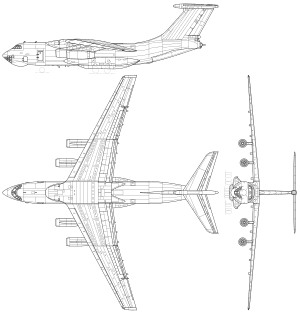Ilyushin Il-76
Military versions of the Il-76 have been widely used in Europe, Asia and Africa, including use as an aerial refueling tanker and command center.The aircraft was conceived by Ilyushin in 1967 to meet a requirement for a freighter able to carry a payload of 40 tonnes (88,000 lb) over a range of 5,000 kilometres (2,700 nmi; 3,100 mi) in less than six hours, able to operate from short[vague] and unprepared airstrips, and capable of coping with the worst weather conditions likely to be experienced in Siberia and the Soviet Union's Arctic regions.[citation needed] From 2004 onwards, a number of aircraft in commercial service were modernized to the Il-76TD-90VD version; this involved the adoption of the newly developed PS-90 engine to comply with European noise limitations.[citation needed] In June 2013, Russian military export agency Rosoboronexport announced an order by China for 12 Il-76MD aircraft.[4] Another application for the type was found in Antarctic support flights and for conducting simulated weightlessness training for cosmonauts (akin to the "Vomit Comet" used by NASA).[7] Beriev and NPO Almaz also developed an airborne laser flying laboratory designated A-60, of which two were built, much of this project's details remaining classified.Il-76s were often hit by shoulder-launched Stinger and Strela heat-seeking missiles and large-calibre machine gun fire, but because the strong airframes were able to take substantial damage and remain operational, the aircraft had a remarkably low attrition rate during this period of conflict.














Military operators
Civilian operators
Military and civilian operators












Illinois Route 76Russian Air ForceairlifterSoviet UnionRussiaIlyushinTashkent Aviation Production AssociationAviastar-SPSoviet Air ForcesRussian Aerospace ForcesPeoples Liberation Army Air ForceIndian Air ForceIlyushin Il-78Beriev A-50Beriev A-100KJ-2000RussianNATO reporting nameturbofanstrategic airlifterAntonov An-12aerial refuelingaerial firefightingzero-Ghigh-wingfour turbofansT-tailTashkentUzbekistanSoloviev D-30People's Republic of ChinaRosoboronexportairborne refuelling tankerwaterbomberBerievA-50 'Mainstay'Antarcticsimulated weightlessnesscosmonautsNPO Almazairborne laserAviastarUlyanovskAeroflotStingerStrelaattrition ratePeople's Liberation Army Air ForceSyrian Air ForceSyrianairTehranVnukovo AirportSyrian banknotesBashar al-Assadinternational sanctionsAviadvigatel PS-90Beriev A-60flight navigatorGromov Flight Research InstituteRaduga Kh-55 cruise missileReduced-gravity aircraftYuri Gagarin Cosmonaut Training CenterGSh-23brandnameRoyal Jordanian Air ForceEgyptian Air Forcefirefighting aircraftC-130 HerculesVolga-Dnepr Airlinesglass cockpitPhalcon radarChinesefibreglassplasticThomson-CSFPersian Gulf WarcrashedHESA SaeqehTransAVIAexport AirlinesAlgeriaAlgerian Air ForceAngolaNational Air Force of AngolaArmeniaArmenian Air ForceAzerbaijanAzerbaijani Air Forces and Air Defense TroopsBelarusAir Force and Air Defence Forces of BelarusPerth AirportAustraliaSearch for Malaysia Airlines Flight 370Il-78MDemocratic Republic of the CongoAir Force of the Democratic Republic of the CongoEquatorial GuineaEquatorial Guinea National GuardKushok Bakula Rimpochee AirportIl-78MKIA-50EIIslamic Republic of Iran Air ForceIslamic Revolutionary Guards Corps Aerospace ForceJordanChkalovsky Air BaseNational Guard of RussiaBorder Service of the Federal Security Service of the Russian FederationRossiya - Special Flight DetachmentSudanese Air ForceUzbekistan Air and Air Defence ForcesBeijing Capital International AirportIraqi Air ForceLibyan Air ForceUkraineUkrainian Air ForceYemeni Air ForceZimbabweAir Force of ZimbabwePouya AirMehrabad AirportAzal Avia CargoSilk Way AirlinesTransAVIAexportFrankfurt AirportKazakhstanGovernment of KazakhstanAir Koryo

